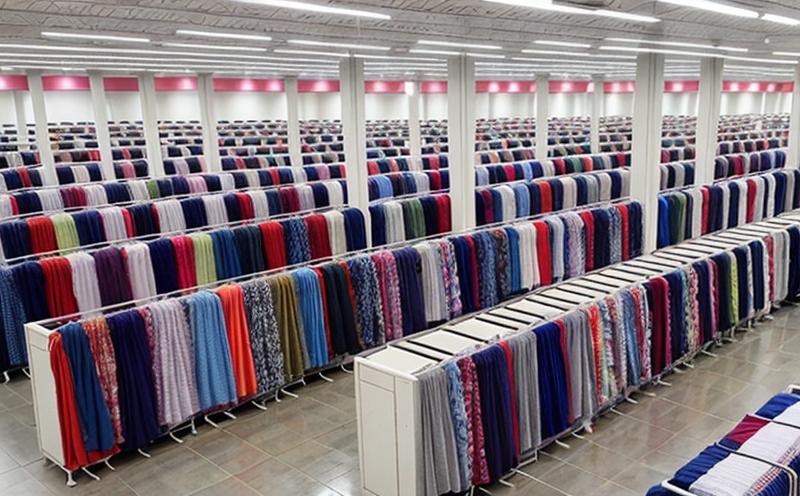ASTM D5034 Textile Breaking Strength Testing for Export Fabrics
The ASTM D5034 standard is a critical method used in testing textile breaking strength, which is essential for ensuring the durability and performance of fabrics intended for export. This test assesses how much force can be applied to a fabric sample before it breaks, providing valuable insights into the material's robustness and suitability for various applications.
The ASTM D5034 protocol involves measuring the tensile strength in both warp and fill (fill being the crosswise direction of the weave) directions. The test is particularly important when dealing with textiles that will undergo physical stress during manufacturing or use, such as garments, upholstery materials, and industrial fabrics.
The specimen preparation for ASTM D5034 involves cutting rectangular specimens from the fabric according to specific dimensions outlined in the standard. These samples are then clamped into a tensile testing machine where they are subjected to gradually increasing forces until failure occurs. The force at which this happens is recorded and reported as the breaking strength.
The process ensures compliance with international standards, thereby enhancing quality control and facilitating smoother trade processes for manufacturers and exporters of textiles. Compliance with such tests helps in reducing disputes during trade negotiations and ensures that exported goods meet both domestic and foreign regulatory requirements.
For accurate and reliable results, it is crucial to use precision instruments like electronic universal testing machines (UTMs) equipped with appropriate grips and fixtures suitable for fabric samples. The test requires careful handling of the specimens to prevent any external factors from influencing the outcome. Proper calibration of equipment and adherence to standard procedures are paramount in ensuring consistent and repeatable results.
The ASTM D5034 method is widely recognized and accepted across many sectors, including government agencies responsible for trade facilitation, which further emphasizes its importance in facilitating smooth international transactions involving textiles. By adhering to this standard, exporters can ensure that their products meet the stringent quality criteria set by importing countries.
The testing process not only ensures compliance with international standards but also helps manufacturers identify potential weaknesses in their fabrics early on, allowing for improvements before large-scale production begins. This proactive approach can lead to better product performance and increased customer satisfaction upon delivery of goods.
In summary, ASTM D5034 textile breaking strength testing is an indispensable tool in the quality assurance process for textiles destined for export markets. It plays a vital role in maintaining high standards of craftsmanship while also promoting efficient trade practices within global supply chains.
Benefits
- Enhanced Quality Control: Ensures that exported fabrics meet the required strength standards, thus enhancing overall product quality.
- Facilitates Smooth Trade: By meeting international standards, this test helps in avoiding trade barriers and disputes during transactions.
- Improves Product Performance: Identifies any potential flaws early on so that necessary adjustments can be made before large-scale production starts.
- Increases Customer Satisfaction: Ensures that delivered goods meet the expected quality levels, leading to higher customer satisfaction and loyalty.
Customer Impact and Satisfaction
For quality managers and compliance officers, ASTM D5034 textile breaking strength testing offers a robust framework for ensuring product integrity. By implementing this test as part of their regular checks, they can rest assured that the fabrics meet international standards and are ready for export markets.
R&D engineers benefit from this service by being able to refine fabric designs based on detailed breaking strength data obtained through ASTM D5034 tests. This information is invaluable in developing new products that not only comply with global regulations but also stand out in the competitive market.
Procurement teams can leverage the results of these tests when selecting suppliers, ensuring that they are sourcing materials from reputable manufacturers who adhere to strict quality control measures. This strategic approach helps maintain a high level of product consistency across different batches and deliveries.
The success stories of satisfied customers include numerous instances where companies have reported improved export performance after incorporating ASTM D5034 testing into their supply chain processes. These companies now enjoy better relationships with importers, reduced costs associated with rejections or returns, and increased market share due to superior product offerings.
Competitive Advantage and Market Impact
Adhering to ASTM D5034 standards can provide significant competitive advantages for textile manufacturers and exporters. It demonstrates a commitment to quality that resonates well with both domestic customers and international buyers.
Compliance with this standard can lead to higher levels of trust among stakeholders, including distributors, retailers, and end-users. This increased confidence translates into greater market acceptance and loyalty towards the brand or company offering such high-quality products.
The ability to consistently meet stringent standards also opens up new opportunities for expansion into lucrative markets where regulatory compliance is essential. It enables businesses to tap into emerging trends in sustainable fashion by providing eco-friendly options that satisfy both environmental concerns and consumer demands for durability and longevity of clothing items.
In conclusion, ASTM D5034 textile breaking strength testing plays a crucial role in shaping the future landscape of the textile industry by fostering innovation, enhancing quality assurance practices, and promoting responsible business conduct. As global trade continues to evolve, so too must our commitment to upholding these high standards.





